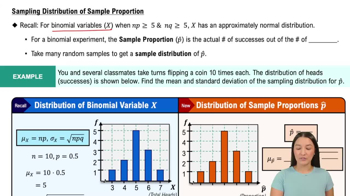Examine the following p chart for defective calculator batteries and briefly describe the action that should be taken.
Table of contents
- 1. Intro to Stats and Collecting Data1h 14m
- 2. Describing Data with Tables and Graphs1h 55m
- 3. Describing Data Numerically2h 5m
- 4. Probability2h 16m
- 5. Binomial Distribution & Discrete Random Variables3h 6m
- 6. Normal Distribution and Continuous Random Variables2h 11m
- 7. Sampling Distributions & Confidence Intervals: Mean3h 23m
- Sampling Distribution of the Sample Mean and Central Limit Theorem19m
- Distribution of Sample Mean - Excel23m
- Introduction to Confidence Intervals15m
- Confidence Intervals for Population Mean1h 18m
- Determining the Minimum Sample Size Required12m
- Finding Probabilities and T Critical Values - Excel28m
- Confidence Intervals for Population Means - Excel25m
- 8. Sampling Distributions & Confidence Intervals: Proportion1h 12m
- 9. Hypothesis Testing for One Sample3h 29m
- 10. Hypothesis Testing for Two Samples4h 50m
- Two Proportions1h 13m
- Two Proportions Hypothesis Test - Excel28m
- Two Means - Unknown, Unequal Variance1h 3m
- Two Means - Unknown Variances Hypothesis Test - Excel12m
- Two Means - Unknown, Equal Variance15m
- Two Means - Unknown, Equal Variances Hypothesis Test - Excel9m
- Two Means - Known Variance12m
- Two Means - Sigma Known Hypothesis Test - Excel21m
- Two Means - Matched Pairs (Dependent Samples)42m
- Matched Pairs Hypothesis Test - Excel12m
- 11. Correlation1h 6m
- 12. Regression1h 50m
- 13. Chi-Square Tests & Goodness of Fit1h 57m
- 14. ANOVA1h 57m
1. Intro to Stats and Collecting Data
Intro to Stats
Problem 1.1.8
Textbook Question
Determine whether the statement is true or false. If it is false, rewrite it as a true statement.
Inferential statistics involves using a population to draw a conclusion about a corresponding sample.
 Verified step by step guidance
Verified step by step guidance1
Understand the definition of inferential statistics: Inferential statistics involves using data from a sample to make generalizations or draw conclusions about a population, not the other way around.
Identify the error in the given statement: The statement incorrectly claims that inferential statistics uses a population to draw conclusions about a sample, which is the reverse of its actual purpose.
Rewrite the statement correctly: Inferential statistics involves using a sample to draw conclusions about a corresponding population.
Reflect on the importance of sampling: Explain that sampling is a practical approach because it is often impossible or impractical to collect data from an entire population.
Consider examples of inferential statistics: Examples include hypothesis testing, confidence intervals, and regression analysis, all of which use sample data to infer characteristics of a population.
 Verified video answer for a similar problem:
Verified video answer for a similar problem:This video solution was recommended by our tutors as helpful for the problem above
Video duration:
3mPlay a video:
Was this helpful?
Key Concepts
Here are the essential concepts you must grasp in order to answer the question correctly.
Inferential Statistics
Inferential statistics is a branch of statistics that allows us to make conclusions about a population based on a sample of data drawn from that population. It involves using probability theory to estimate population parameters, test hypotheses, and make predictions. This contrasts with descriptive statistics, which only summarizes the data at hand.
Recommended video:
Guided course

Parameters vs. Statistics
Population vs. Sample
In statistics, a population refers to the entire group of individuals or instances about which we seek to draw conclusions, while a sample is a subset of that population selected for analysis. The goal of inferential statistics is to use the sample data to infer characteristics or behaviors of the larger population, making it crucial to ensure that the sample is representative.
Recommended video:

Sampling Distribution of Sample Proportion
True Statement Revision
When a statement is found to be false, it is important to revise it to reflect the correct information. In this context, the original statement incorrectly suggests that inferential statistics uses a population to draw conclusions about a sample, when in fact it is the other way around: inferential statistics uses a sample to make inferences about a population.
Recommended video:
Guided course

Step 1: Write Hypotheses

 2:13m
2:13mWatch next
Master Introduction to Statistics Channel with a bite sized video explanation from Patrick
Start learningRelated Videos
Related Practice
Textbook Question
1
views
